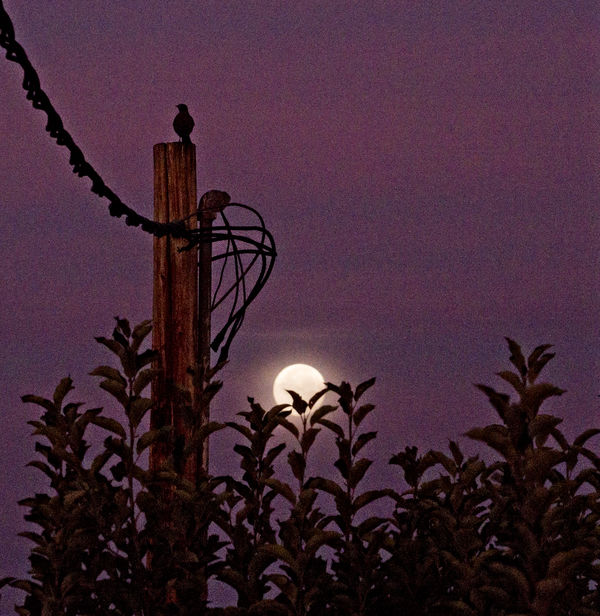Have any of you used "Noise" creatively in your photography?
Jul 22, 2018 10:27:04 #
The instructor of a photography class I attended many years ago had a Minox subminiature camera in his gear collection (y'all remember those, right?). He could then say to clients "you want grain? I'll give you grain..."
I've seen many "grainy" photos that wouldn't have worked half as well without the grain. So grain can be and has been used as a creative tool to create moods, add an element of mystery, etc. But is digital "Noise" comparable to grain in that respect? Or is it always as objectionable (even "hateful") as some would have it? I know Noise is to be avoided in many (most?) forms of photography, but can it also be used creatively?
Curious how you all view this....If anyone has examples I'd love to see them!
I've seen many "grainy" photos that wouldn't have worked half as well without the grain. So grain can be and has been used as a creative tool to create moods, add an element of mystery, etc. But is digital "Noise" comparable to grain in that respect? Or is it always as objectionable (even "hateful") as some would have it? I know Noise is to be avoided in many (most?) forms of photography, but can it also be used creatively?
Curious how you all view this....If anyone has examples I'd love to see them!
Jul 22, 2018 10:52:41 #
`
Below is digital fake grain. Depending on the
nature of your image, tone breaks, "mood",
smooth or textured subjects, it will pass as
real or look really fake. It is Olympus' grain
"filter", and I've read that it is considered to
be exceptional, so maybe other grain filters
will be less acceptable.
Below is digital fake grain. Depending on the
nature of your image, tone breaks, "mood",
smooth or textured subjects, it will pass as
real or look really fake. It is Olympus' grain
"filter", and I've read that it is considered to
be exceptional, so maybe other grain filters
will be less acceptable.
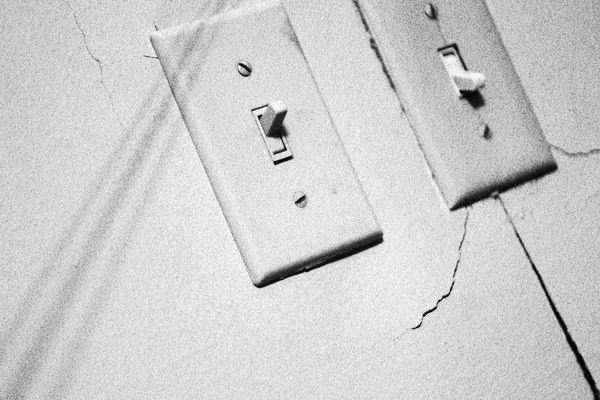
Jul 22, 2018 11:10:17 #
Digital noise or fake grain just never looks as good as real film grain. I used to shoot TMax 3200 B&W film, and I loved the grain. But I avoid digital noise as much as possible.
Jul 22, 2018 11:13:36 #
First of all, thank you from the bottom of my heart for posting a non-complaint topic in main discussion forum. Just when I thought all hope was lost 
This is a combo of elements: a bit of original noise, a "grainy" texture added, and other edits.
The original is #2.
Thanks again!
-

This is a combo of elements: a bit of original noise, a "grainy" texture added, and other edits.
The original is #2.
Thanks again!
-
A Raven at Moonset. ISO 3200, Olympus EM10 camera.
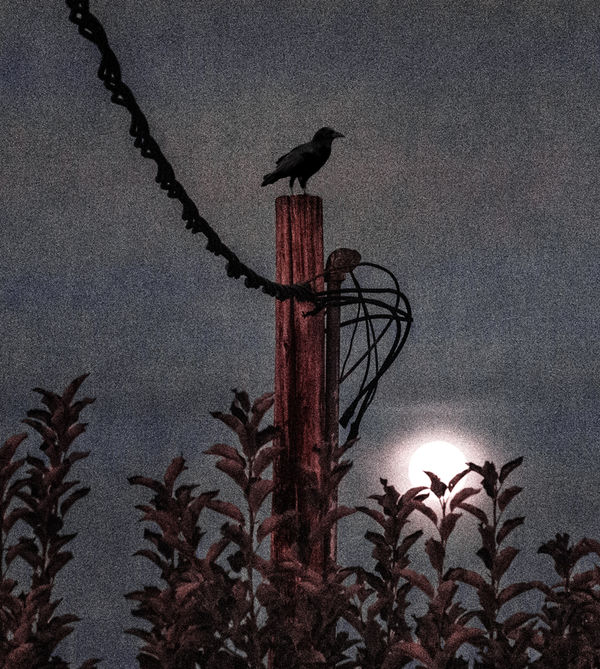
(Download)
The color is from sun (behind me) just about to peek over the hoirzon.
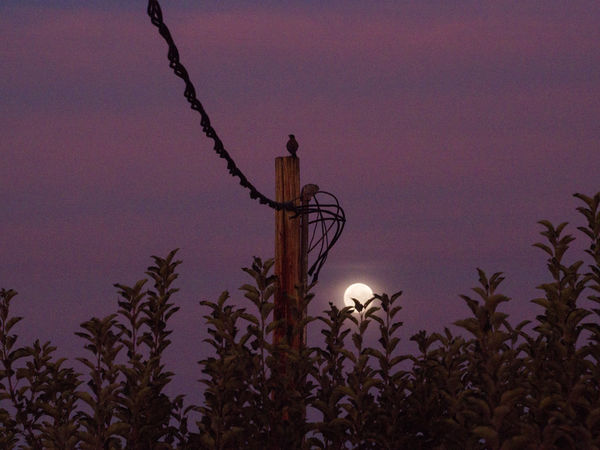
(Download)
Jul 22, 2018 11:35:07 #
`
As to "creative use" of noise, most camera original
noise has no creative use. You have little to no real
control over it other than sweepingly large control
as in "Hugely more of it" as you really crank up the
ISO. But the "aethetic quality" rather than quantity
of camera noise is not readily controlled.
OTOH there are "add noise" filters in post that are
very versatile, and when used properly will pass for
camera noise. So sometimes I'll "add noise to hide
noise". Explanation and example to follow :-)
In many night scenes, there's visible noise that
looks OK, meaning it's sorta evenly applied, much
like our beloved old [real] film grain. Problem is it
won't look so "even" throughout the image. This
seems governed by the subject details or textures
that are rendered differently throughout an image,
and also by the brightness of various areas.
Often, and fortunately, the areas where in-camera
noise looks worse, not MORE but WORSE, are just
a bit brighter than the very darkest areas, and are
areas where detail or texture [if any] are not very
sharply focused.
OK. Areas not crisply rendered and-or kinda dark
must be areas that are NOT the centers of interest.
They may be parts OF the SUBJECT of interest, but
to the eye they lack what it takes to hold interest.
IOW these are areas where we can, if needed, do
somewhat crude things without drawing too much
attention from our viewers.
Sometimes ... too often ... the areas in question
are negatively drawing attention cuz they tend to
display ugly, uneven noise and artifacts. Easily we
can use various tricks to soften or blur away such
stuff. Easy enuf to make it gone, but what remains
also draws attention. What remains is not ugly but
it IS different looking than the rest of the image
where we have visible noise that we will "let live",
cuz it's "even" and not ugly ... "well behaved" like
our bygone film grain.
So ... we have multiple smallish areas where we
treated the uglier camera noise but the treatment
has left them looking different, texture-wise, than
the untreated majority of the image area. And they
look just different enuf to draw some attention to
themselves ... IOW distracting. Use of "add noise"
filters can put fake noise patterns into those areas
to make them match the visual texture of the rest
of the image. Fake noise is very adjustable so you
can tweak it to match the rest of the image. Fake
noise has no disturbing artifacts like the ugly real
in-camera noise we removed.
Top image is the whole frame.
2nd image is some ugly noise before treatment.
3rd image is same area but softened by noise
reduction treatments, then fake noise added.
4th image is a detail of untreated noise within a
section of the center of interest. Not distracting
nor ugly, due to the tone and detail in this area.
As to "creative use" of noise, most camera original
noise has no creative use. You have little to no real
control over it other than sweepingly large control
as in "Hugely more of it" as you really crank up the
ISO. But the "aethetic quality" rather than quantity
of camera noise is not readily controlled.
OTOH there are "add noise" filters in post that are
very versatile, and when used properly will pass for
camera noise. So sometimes I'll "add noise to hide
noise". Explanation and example to follow :-)
In many night scenes, there's visible noise that
looks OK, meaning it's sorta evenly applied, much
like our beloved old [real] film grain. Problem is it
won't look so "even" throughout the image. This
seems governed by the subject details or textures
that are rendered differently throughout an image,
and also by the brightness of various areas.
Often, and fortunately, the areas where in-camera
noise looks worse, not MORE but WORSE, are just
a bit brighter than the very darkest areas, and are
areas where detail or texture [if any] are not very
sharply focused.
OK. Areas not crisply rendered and-or kinda dark
must be areas that are NOT the centers of interest.
They may be parts OF the SUBJECT of interest, but
to the eye they lack what it takes to hold interest.
IOW these are areas where we can, if needed, do
somewhat crude things without drawing too much
attention from our viewers.
Sometimes ... too often ... the areas in question
are negatively drawing attention cuz they tend to
display ugly, uneven noise and artifacts. Easily we
can use various tricks to soften or blur away such
stuff. Easy enuf to make it gone, but what remains
also draws attention. What remains is not ugly but
it IS different looking than the rest of the image
where we have visible noise that we will "let live",
cuz it's "even" and not ugly ... "well behaved" like
our bygone film grain.
So ... we have multiple smallish areas where we
treated the uglier camera noise but the treatment
has left them looking different, texture-wise, than
the untreated majority of the image area. And they
look just different enuf to draw some attention to
themselves ... IOW distracting. Use of "add noise"
filters can put fake noise patterns into those areas
to make them match the visual texture of the rest
of the image. Fake noise is very adjustable so you
can tweak it to match the rest of the image. Fake
noise has no disturbing artifacts like the ugly real
in-camera noise we removed.
Top image is the whole frame.
2nd image is some ugly noise before treatment.
3rd image is same area but softened by noise
reduction treatments, then fake noise added.
4th image is a detail of untreated noise within a
section of the center of interest. Not distracting
nor ugly, due to the tone and detail in this area.
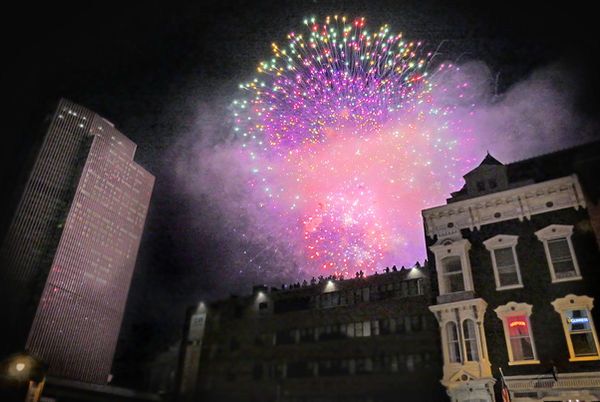
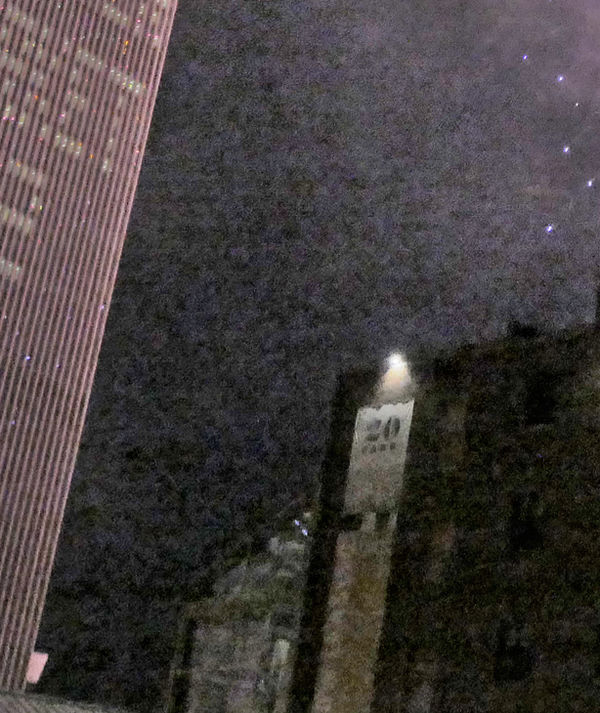
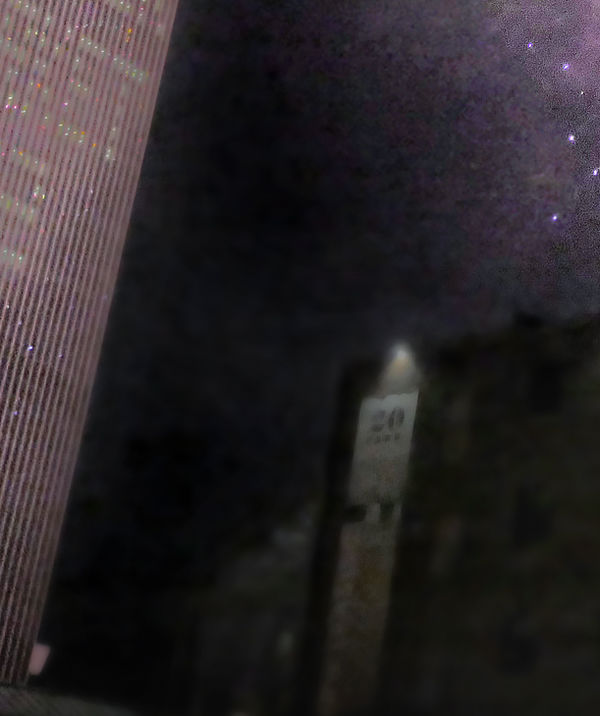
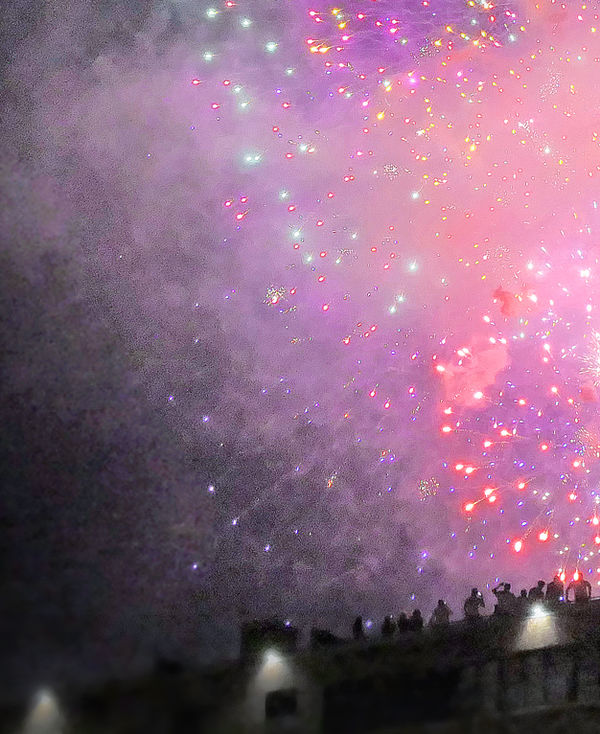
Jul 22, 2018 11:35:43 #
mwsilvers
Loc: Central New Jersey
srt101fan wrote:
The instructor of a photography class I attended m... (show quote)
Digital noise is very different from film grain. I often apply film grain effects from a variety of different films creatively to my digital images, but always attempt to remove as much digital noise as possible since it always detracts from an image in my opinion.
Jul 22, 2018 11:39:59 #
User ID wrote:
Many great tips and observations, thanks!` br br As to "creative use" of no... (show quote)
Jul 22, 2018 11:50:02 #
Decided to post a crop of the original, slightly edited (note I kept the less interesting bird that came with the scene, lol). Though I generally go for soft & dreamy when not texturizing, I don't see why this couldn't be a valid interpretation with its original noise.
I'm sure there are many "gritty" street-type scenes, especially those converted to b&w, that would be appropriate.
I'm sure there are many "gritty" street-type scenes, especially those converted to b&w, that would be appropriate.
Jul 22, 2018 12:36:46 #
JohnSwanda wrote:
Digital noise or fake grain just never looks as
good as real film grain. I used to shoot TMax
3200 B&W film, and I loved the grain. But I
avoid digital noise as much as possible.
Digital noise or fake grain just never looks as
good as real film grain. I used to shoot TMax
3200 B&W film, and I loved the grain. But I
avoid digital noise as much as possible.
TMax 3200 . .. "TMZ" by code, love that code
name, cuz I think when said aloud it SOUNDS
like TMX images LOOK. Or mebbe just mental
short circuiting ....
OK mebbe that sounds crazy, or not. But I've
shot miles and miles of TMZ and I looooved it.
Never used any "fine grain" developers on it.
Always in HC110.
But that was then, and this is now. My taste in
grain was formed by TMZ back then, but now I
hafta carry that taste forward as a metric even
tho nothing digital truly compares.
Remember how TMZ made projected enlarger
images sooper easy to focus ? No eyestrain :-)
`
Jul 22, 2018 13:04:22 #
Grain, yes. But not digital noise - I don't find it appealing and I can't imagine I will every use it as a creative effect. At least not color digital noise, with its random magenta and green blotches. Digital noise in black and white is a little more palatable, but a smooth grain is more pleasing.
Jul 22, 2018 13:46:14 #
srt101fan wrote:
The instructor of a photography class I attended m... (show quote)
NO
If I want a bit of grittiness I use B&W film.
It seems MOST CRAPPY photography is always improved by noise!!! LoL
Kinda the old-school equivalent of over-saturation, today!!
SS
Jul 22, 2018 14:59:27 #
amfoto1
Loc: San Jose, Calif. USA
I shot this white-crowned sparrow on film through the "natural filtration" of tall grasses in the foreground strongly de-focused by a very long focal length.... Later "amplified" the film grain during scanning, simply because I thought it looked better.

Here's another image originally shot on film, where I added much stronger grain effects.
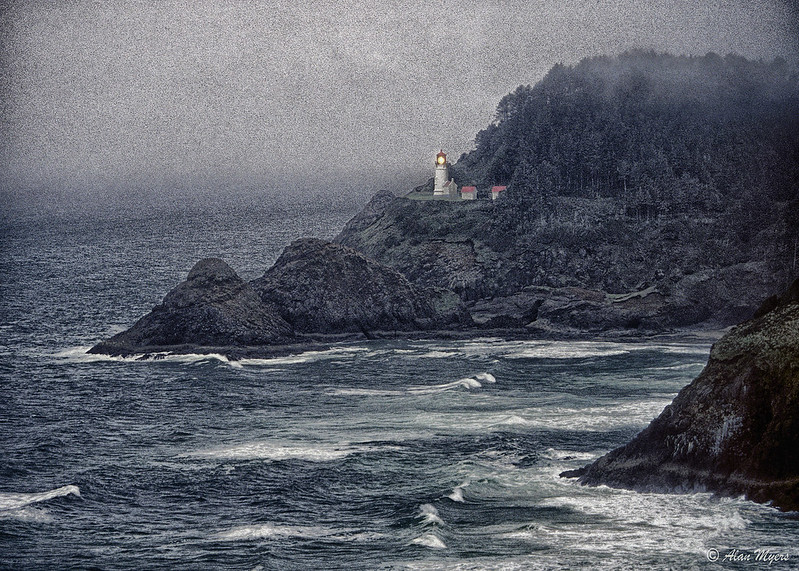
Heceta Head Lighthouse in Oregon... It was a nasty cold and rainy day.... terrible for photography and photographers but seemed like perfect weather for a lighthouse! I've seen lots of "scenic" shots of this LH taken on sunny, clear days.... Those just don't seem to mesh with the purpose of a LH and I was happy to try something different, although the weather was so nasty I shot fast. After scanning the film I found the "straight" image was flat and low-contrast... with a lot of detail obscured by the fog and rain... nothing special. Among some other things, I think the grain effects really enhanced it. In this case it was done using a Nik filter plug-in with Photoshop.

Here's another image originally shot on film, where I added much stronger grain effects.

Heceta Head Lighthouse in Oregon... It was a nasty cold and rainy day.... terrible for photography and photographers but seemed like perfect weather for a lighthouse! I've seen lots of "scenic" shots of this LH taken on sunny, clear days.... Those just don't seem to mesh with the purpose of a LH and I was happy to try something different, although the weather was so nasty I shot fast. After scanning the film I found the "straight" image was flat and low-contrast... with a lot of detail obscured by the fog and rain... nothing special. Among some other things, I think the grain effects really enhanced it. In this case it was done using a Nik filter plug-in with Photoshop.
Jul 22, 2018 17:02:36 #
`
Kudos on the lighthouse image. I neither love nor
despise the texture filter, basically take it or leave
it [mebbe just a tiny bit more toward leave it] but
I find the image itself has feeling, place, time, all
the stuff that makes for a sense of reality.
Also it's great to see such a scene without the sick
old cliches that get lathered onto such views, the
worst being long-exposure water blurring. You got
the white caps. That tells the power of the water,
not that misty BS, an alien look never seen by our
own human eyes. And as you mention, the whole
"sunny day at the shore" cliche doesn't say much
... says zilch really ... about light house realities.
PS: Longer I look, more I lean toward dumping
texture filter. Not so much about any dislike of the
effect as a visual ploy, but more becuz the longer
I look the more I wonder what the scene really
looks like "naked". Yeah. I try to "undress it with
my eyes", but I wanna see it "take it all off" so I
can stop guessing :-)
`
Kudos on the lighthouse image. I neither love nor
despise the texture filter, basically take it or leave
it [mebbe just a tiny bit more toward leave it] but
I find the image itself has feeling, place, time, all
the stuff that makes for a sense of reality.
Also it's great to see such a scene without the sick
old cliches that get lathered onto such views, the
worst being long-exposure water blurring. You got
the white caps. That tells the power of the water,
not that misty BS, an alien look never seen by our
own human eyes. And as you mention, the whole
"sunny day at the shore" cliche doesn't say much
... says zilch really ... about light house realities.
PS: Longer I look, more I lean toward dumping
texture filter. Not so much about any dislike of the
effect as a visual ploy, but more becuz the longer
I look the more I wonder what the scene really
looks like "naked". Yeah. I try to "undress it with
my eyes", but I wanna see it "take it all off" so I
can stop guessing :-)
`
Jul 22, 2018 17:46:14 #
Thank you all very much for your comments. I confess that when I started this thread I was thinking of digital noise vs. film grain and didn't even think of "artificial grain" added in post-processing (I'm just starting to seriously learn about PP and haven't gotten into effects yet). But you all addressed both and that's great.
Thanks for the great images and your comments on processing. I learned a lot and am eager to play around with PP grain effects (once I get past the basics!)
Your "raven" image is really cool, Linda, and the grain effect in Alan's lighthouse photo is amazing. User ID, thanks for the tutorial; very educational for me to see the effects in the image details. One thing I found interesting is how well grain effect works in your color photos. In my film days I shot almost all in black & white and I still love black & white images. Right now I have my digital camera set to save JPEGs plus RAW, with the monochrome setting applied to the JPEGs so that I can see the effect in the monitor. I'm not really sure why, but I guess I need time to sort out where I'm going with all this....
Thanks again, you all have been very helpful!
Thanks for the great images and your comments on processing. I learned a lot and am eager to play around with PP grain effects (once I get past the basics!)
Your "raven" image is really cool, Linda, and the grain effect in Alan's lighthouse photo is amazing. User ID, thanks for the tutorial; very educational for me to see the effects in the image details. One thing I found interesting is how well grain effect works in your color photos. In my film days I shot almost all in black & white and I still love black & white images. Right now I have my digital camera set to save JPEGs plus RAW, with the monochrome setting applied to the JPEGs so that I can see the effect in the monitor. I'm not really sure why, but I guess I need time to sort out where I'm going with all this....
Thanks again, you all have been very helpful!
Jul 22, 2018 18:33:03 #
`
srtfan101, do realize that there's different filters,
thus different results, for "add noise" and "grain".
I might have not made that clear. Both are rather
adjustable in degree and nature of effect but are
two different things. "Add Noise" is not just some
alternate term for the "Grain" filter.
Adding grain is an aesthetic choice. Adding noise
is sometimes necessary to hide your retouching
work. Some retouch tools reduce local sharpness
and so reduce or erase local noise as well. This
textural difference catches the eye, so you add
just the right amount of fake noise to make the
retouched area match its surroundings.
Also, if you clone an element from one image
into another image, if their noise levels don't
match well, even tho both noise levels are too
low-level to "look noisy", we somehow notice
the small difference and the cloning somehow
fails to look natural. Subtle things affect the
credibility of our deceptions.
`
srtfan101, do realize that there's different filters,
thus different results, for "add noise" and "grain".
I might have not made that clear. Both are rather
adjustable in degree and nature of effect but are
two different things. "Add Noise" is not just some
alternate term for the "Grain" filter.
Adding grain is an aesthetic choice. Adding noise
is sometimes necessary to hide your retouching
work. Some retouch tools reduce local sharpness
and so reduce or erase local noise as well. This
textural difference catches the eye, so you add
just the right amount of fake noise to make the
retouched area match its surroundings.
Also, if you clone an element from one image
into another image, if their noise levels don't
match well, even tho both noise levels are too
low-level to "look noisy", we somehow notice
the small difference and the cloning somehow
fails to look natural. Subtle things affect the
credibility of our deceptions.
`
If you want to reply, then register here. Registration is free and your account is created instantly, so you can post right away.


